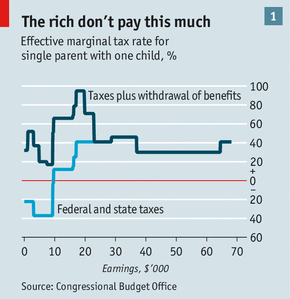| Online: | |
| Visits: | |
| Stories: |

| Story Views | |
| Now: | |
| Last Hour: | |
| Last 24 Hours: | |
| Total: | |
Who Has the Highest Marginal Tax Rate: the Rich or the Poor?
Tuesday, August 11, 2015 0:27
% of readers think this story is Fact. Add your two cents.
Anthony B. Atkinson has produced an in-depth discussion of inequality, its causes, and its possible remedies in his book Inequality: What Can Be Done? Atkinson is a British economist who has been studying the issue for decades and is recognized as one of the foremost experts on the topic. He ultimately arrives at 15 specific recommendations for changes in public policy that should contribute to a shrinking of the growing gap between the rich and the poor.
It is not surprising that more progressive taxation of income is one of his proposals.
“Proposal 8: We should return to a more progressive rate structure for the personal income tax, with marginal rates of tax increasing by ranges of taxable income, up to a top rate of 65 per cent, accompanied by a broadening of the tax base.”
Atkinson provides a discussion of all the ways an economist might choose to select the highest marginal rate with arguments about efficiency and incentives. He casts aside all such efforts as being too imprecise for the task at hand. Instead he decides on the value of 65% out of considerations of fairness. Fairness?
One must recall that Atkinson is British so the particulars of his proposals tend to be specific to Great Britain. Usually he translates the specifics of his discussions to the slightly different realities that exist in the United States, but he failed to do that in his “fairness” argument. We shall do that for him.
Atkinson argues that a fair highest tax rate is one that is potentially applied to all taxpayers. In particular, a high-income marginal rate should not be below any rate that people lower in income might be subject to.
“A maximum fair marginal tax rate—in terms of what people keep as a result of extra effort—should be the same for everyone. Applying this principle suggests a quite different criterion for the top tax rate: that the marginal rate at the top of the income distribution should be the same as that applied at the bottom of the scale.”
What is of concern to Atkinson is what is referred to as “the poverty trap” or “the welfare trap.” Assistance based on means testing is withdrawn as the beneficiary acquires income that exceeds certain levels. As those income levels are reached the withdrawal of government benefits affects the income of the worker in the same way a marginal tax would. If the benefits are withdrawn suddenly, the effective marginal tax rate can be quite large. Atkinson’s proposal was chosen to match the targeted effective marginal rate that the UK has proposed as the most that people emerging from poverty should be required to pay: 65%.
That is an interesting application of the concept of fairness. What might be derived from applying that same logic to the United States? Fortunately that calculation has already been done and has been presented in an article in The Economist: Taxing hard-up Americans at 95%. The title already provides the answer.
The results presented are based on a calculation by the Congressional Budget Office (CBO). The CBO took the hypothetical case of a single mother with one child in the state of Pennsylvania and calculated the effective marginal tax implied by the loss of benefits with increasing income. The article provides those numbers in the following chart.
Clearly, Atkinson’s approach to determining the top marginal rate could never be applied in the United States. However, his emphasis on fairness does raise an interesting question. When increases in tax rates are proposed, fairness is one of the primary arguments by the wealthy against being forced to pay a higher marginal rate. The second standard argument in defense of the rich is that higher taxes act as a disincentive for the wealthy and they might not work as hard as they might otherwise if a greater fraction is taken from any additional income. One has to wonder if the wealthy would accept the argument that high marginal rates for the poor would be unacceptable because they would be unfair and would act as too much of a disincentive to work harder. They might, actually, if they took the time to think about it.
Another take-away from the chart above is that we have a complex system for providing assistance to the needy. That is evident from the structure in the marginal tax curve. There are a significant number of programs available to the needy, but the bureaucracies put in place to protect the funds we allocate to them from “abuse” make it difficult for any one person to access all, or even any of them.
Couldn’t we at least recognize that a system that that makes it more difficult to make headway for those trying to emerge from our welfare programs is bad policy? Couldn’t we at least be cognizant of the problem and cap the disincentive as Atkinson claims the British are doing?
You can learn a little about a lot of things or you can learn a lot about a very few things. Guess which is the most fun.
Source: http://letstalkbooksandpolitics.blogspot.com/2015/08/who-has-highest-marginal-tax-rate-rich.html




